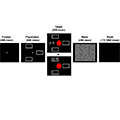Abstract
Although the Stroop effect has been considered to be strong evidence of automatic recognition of word, some studies showed that the Stroop effect is modulated by visual attention. In this study, we investigated the role of visual attention in the involuntary word processing of the Stroop task. Three experiments examined whether the magnitude of the Stroop effect is modulated by the color-word’s ability to capture attention in a bottom-up fashion, namely, via an abrupt onset. The Stroop effect was found to be smaller when the color-word distractor appeared as a part of a pre-existing placeholder than when it appeared abruptly in a blank location around the color-patch target (Experiment 1). Furthermore, dilution of the Stroop effect in the presence of an additional, neutral word depended on which of the two words was presented more abruptly (Experiments 2 & 3), suggesting attentional competition between them. These results imply that the color word in the Stroop task is recognized when it captures attention.
